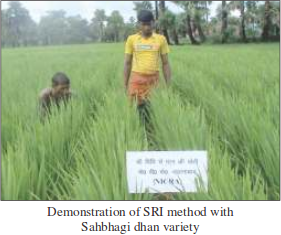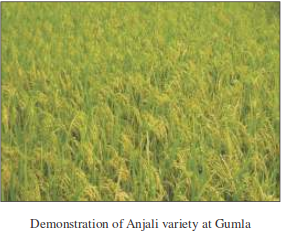Drought tolerant paddy cultivars to tackle deficit rainfall situations
Drought tolerant paddy cultivars to tackle deficit rainfall situations
Climate vulnerability
Drought in rainfed areas
Existing practice
In recent years, deficit rainfall in July is affecting the timely transplanting of paddy in the eastern region in several rainfed districts in Bihar, Jharkhand and Odisha. Long duration (140-150 days) cultivars are preferred by farmers who take up sowing of nursery in June and transplanting in July. However, due to deficit rainfall situation in July, farmers wait for transplanting till August. This results in low productivity and can affect the timely sowing of succeeding rabi crop on the same land.
The remedy therefore lies in the promotion of stress tolerant paddy varieties of shorter duration that are amenable both for transplanting and direct sowing. Short duration and drought tolerant varieties fit well into contingency plans for all types of farming situations (upland, midlands and lowlands) prevalent in the eastern states. Yields with short duration varieties are slightly lower compared to long duration varieties due to early maturation. However, short duration varieties serve as best bet options for drought proofing in rainfed rice cultivation as they provide a significant yield advantage in drought years over the traditional long duration varieties. This implies a trade-off between risk and expected returns in areas experiencing increased frequency of droughts in states such as Bihar and Jharkhand.
Resilient practice / technology
Short duration and drought tolerant varieties that can withstand up to 2 weeks of exposure to dry spells in rainfed areas were demonstrated in select NICRA villages. Drought tolerant cultivars demonstrated in farmers fields include:
- Sahbhagi dhan - 105-110 days duration in plain areas and 110-115 days in uplands, highly resistant to leaf blast and moderately resistant to brown spot and sheath blight. '
- Naveen - 115-120 days duration, released in 2005 for cultivation in Odisha
- Anjali - 90 days duration released in 2003 for Jharkhand.
- Other early maturing varieties that have potential in the eastern states include: 'Birsa Vikas Dhan 109' (85 days duration) and 'Abhishek' (120 days duration).
Impact of drought tolerant varieties of Paddy
- Average yield in farmers fields with Sahbhagi dhan was 34.6 q/ha with an yield advantage of 26% over traditional long duration variety in seasons that experienced deficit rainfall situation as in 2013 at Jehanabad, Aurangabad, Buxar, Saran and Supaul in Bihar; Koderma, Palamu and Gumla in Jharkhand; Jharsuguda in Odisha.
- Average yield of Anjali variety was 41.2 q/ha with an yield advantage of 41% in Gumla and Chatra in Jharkhand.
- Average yield with Naveen variety was 39 q/ha with an yield advantage of 20% over traditional varieties in East Singhbhum in Jharkhand and Buxar in Bihar.
- Average yield with Abhishek variety was 35 q/ha with an yield advantage of 31% over traditional variety at Koderma, Jharkhand.
Scope for upscaling
Drought tolerant paddy varieties were demonstrated on 185 ha covering 463 farmers in Buxar, Jehanabad, Saran, Aurangabad, Supaul in Bihar; Koderma, Gumla, Chatra, East Singhbhum and Palamu in Jharkhand; Jharsuguda, Sonepur and Ganjam in Odisha; Bilaspur in Chhattisgarh, East Sikkim and Port Blair. Yield advantage with these varieties in drought years ranged between 8.3 to 38.4% with a benefit cost ratio of 1.5 to 3.2 when compared to the existing practice of growing long duration varieties.
Availability of suitable varieties of paddy for delayed planting situation is a serious constraint for implementation of contingency plans in districts experiencing deficit rainfall. Solution lies in the promotion of seed production (breeder/ foundation / certified) of high yielding short duration varieties (less than 115 days) and medium duration varieties (125-135 days) for both direct seeding and transplanted conditions. Effective linkages and coordination among the State line departments and State Agricultural Universities is highly desirable for implementation of a successful seed production plan well in advance. Strengthening of scientific storage infrastructure is warranted. In the event of a normal season, mechanism/schemes should be put in place to absorb the difference in cost of disposal other than as seed material. Making villages self-reliant in the local seed requirement of those varieties not in the normal seed chain is imperative for increasing the resilience of the farming community. In case of acute shortage in availability of early or extra early maturing paddy varieties (Prabhat, Turanta Dhan etc.) that were released 10 years back, relaxation for procurement and supply of such varieties in contingent situations provided under the National Food Security Mission (NFSM) can also be explored. Scope exists for promotion and up-scaling of drought tolerant varieties in the rainfed areas in Bihar, Jharkhand, Odisha, Jharkhand and the north-eastern states.



Source: Smart Practices and Technologies for Climate Resilient Agriculture
Last Modified : 3/1/2020
This topic provides information about Captive rear...
This topic defines about the Enhancing resilience ...
This topic provides information about Community ta...
This topic provides information about Crop diversi...
